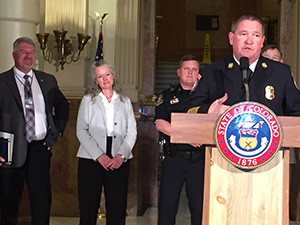(APRIL 14, 2017) -- On April 14, Division of Fire Prevention (DFPC) Director Mike Morgan joined the Governor to share the state's Wildfire Potential for 2017 and provide updates on the level of state preparedness. Representatives from the US Forest Service, Bureau of Land Management, Colorado State Forest Service and the Colorado Division of Homeland Security and Emergency Management (DHSEM) joined the briefing, discussion and planning session.

The number, intensity, and complexity of wildfires in Colorado have been growing exponentially, and experts predict that it will continue to worsen. In the 1960s, Colorado averaged 456 wildfires per year that burned an average of 8,170 acres. Today, an "average" wildfire year for Colorado consists of more than 4,500 fires that burn more than 100,000 acres annually, resulting in $41.8 million in fire suppression expenses.
Each year, scientists and land managers produce coordinated outlooks for fire season across the western U.S. in order to help better prioritize resources. While it is too early to forecast with accuracy what the 2017 fire season will bring, current National Predictive Services models indicate a near average to slightly below average core fire season in 2017.
Director Morgan and Governor Hickenlooper called on Coloradans to take steps to be prepared for and prevent wildfires -- particularly because the vast majority of wildfires were human-caused last year. In 2016, there were 4,743 wildfires that could trace their cause to humans vs. only 819 fires caused by lightning.
Communities and individuals can find wildfire mitigation and prevention tips here.
Meanwhile, DFPC and local agencies have taken steps to be prepared to respond to wildfires. The DFPC Wildfire Preparedness Plan provides an overview of current and historic fire conditions and outlines the Division's goals, objectives, resources, budget and plan for addressing wildfires in Colorado.
A critical aspect of the plan is early detection and response. Fast, aggressive initial attack on new fires can reduce the number of incidents that grow into large wildfires that may burn hundreds of homes and cost taxpayers millions of dollars in suppression costs. DFPC has set a goal of generating an incident assessment for every fire within 60 minutes and providing appropriate aviation suppression support to every fire within 60 minutes of the request from the incident's commanding agency DFPC's multi-mission aircraft, helicopters, and single-engine air tankers will play an important role in this plan.
Last year, the Multi-mission aircraft flew 343 missions to collect and send data to emergency responders battling fires, and the aircraft detected 43 fires that hadn't yet been spotted.
DFPC 2016 response - By the Numbers
- Provided wildfire training sessions to 2,460 students/firefighters
- DFPC engines responded to nearly 800 incidents
- Logged 191 cases of technical assistance/support to local agencies on wildfire incidents
- State-contracted single-engine air tankers dropped 210,000 gallons of retardant
- State-contracted helicopters dropped 208,000 gallons of water and moved nearly 60,000 pounds of cargo.